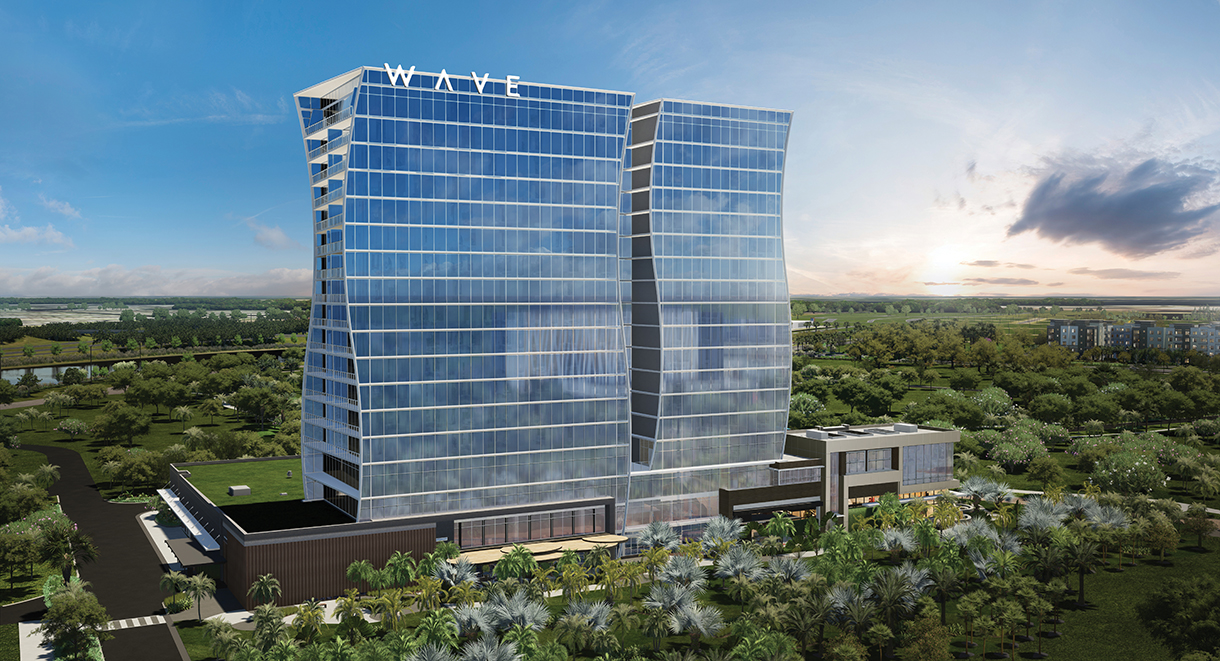
Hotels of the Future
A safe haven with robots—and there will be robots.
Crystal balls are notoriously cloudy, and yet as the science fiction writer William Gibson famously said: “The future is already here. It’s just not evenly distributed.”
Uber may have predicted in 2017 that by today we would be getting around in flying taxis, when reality is the opening in December of Lake Nona Wave Hotel (lakenonawavehotel.com) in Orlando, Florida. The hotel gives credence to Gibson’s notion, billing itself as the centerpiece of the innovative, master-planned community Lake Nona, “a smart city with soul.” Tech is central to life in this community, as it is to the hotel, which incorporates standard issue smart windows, in-room tablets, and a mobile app for accessing guest services. Robot lawn mowers take care of the grounds and autonomous shuttles spirit guests to off-site attractions nearby. Technology extends into the visual sphere with a kinetic chandelier and multiple pieces of digital art designed to stimulate the imagination. Starting in 2025, Lake Nona expects hotel guests to arrive via the state’s first Vertiport, a new type of airport made specifically for electric vertical takeoff and landing (eVTOL) craft made by Lillium, a German aviation company, that operate like an emissions-free air taxi.
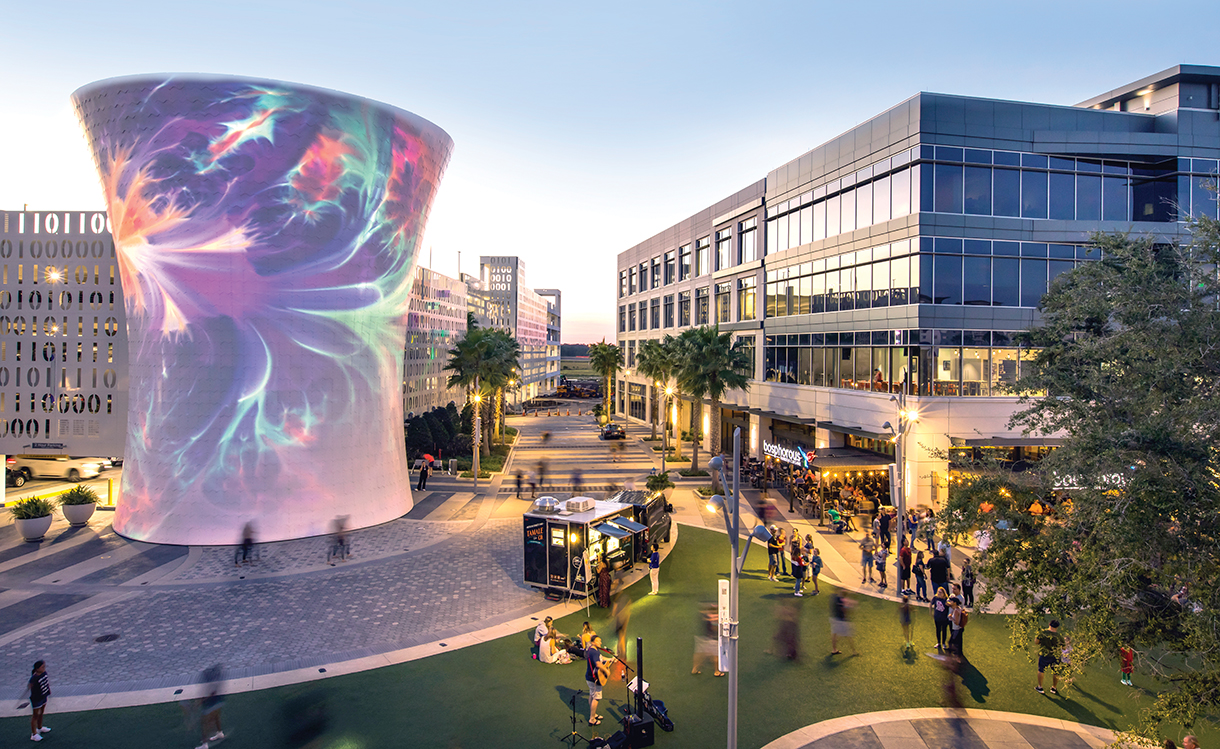

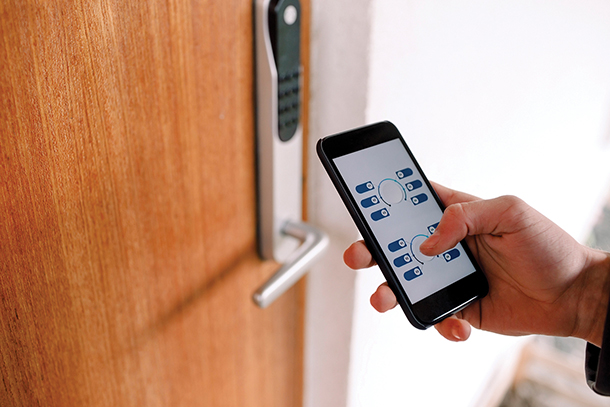
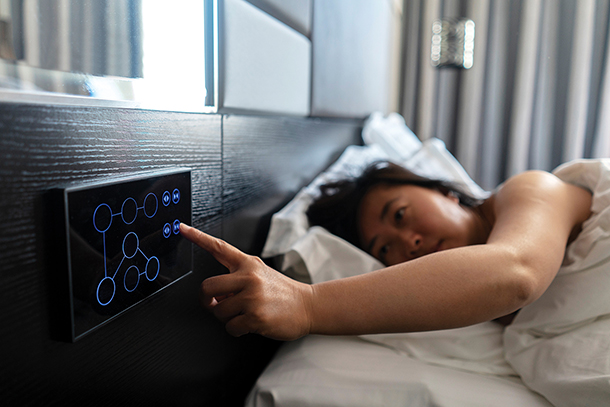
DIGITAL ASSISTANCE
The most important tool for navigating the hotel of the future is already in your hand. The mobile phone will be used for a variety of contactless communications via hotel apps and direct messaging. It will also handle your virtual check-in, serve as a room key, operate various amenities ranging from the TV to the thermostat, and link you to a plethora of guest services. The cell phone is likely to change how you pay for a room—instead of a flat rate, you may be able to cherry-pick amenities you are actually going to use. Some MCR Hotels (mcrhotels.com) already ask guests to pay $25 more for pool access on weekends in a move designed to keep the basic hotel room rate low. But the role model may be Lucy, the “personal comfort assistant” app used by Virgin Hotels (virginhotels.com). Lucy’s skill set continues to grow with every upgrade. Cashless tipping of staff is among her newest abilities, as is room lighting in an era when Zoom calls are routine.
Many of these trends were already in place pre-pandemic, but COVID-19 has accelerated their adoption. With people already accustomed to using voice-controlled digital assistants like Siri at home, guests will likely expect to use this same tech during their hotel stays to order room service, for example. An analysis by the research firm Statista suggests there will be 8.4 billion digital voice assistants in use by 2024—that’s more than the population of the planet. The Westin Buffalo (marriott.com), for example, has already put Echo devices in each of its 115 rooms so guests can access services like Spotify and Pandora. Managed by a software company called Volara, Alexa can now answer questions about hotel services typically asked of staff. When a guest checks out, the devices are automatically cleared of all personal data. Concierges, meanwhile, remain a critical contact, even if it’s only by a high-speed video link, as they may not only need to be knowledgeable about local sites but also the current health protocols associated with them.
CLEANER AIR
When it comes to hotel stays, the big question regarding a choice of hotel room may be: Who has been here before me? The hotel experience was always expected to be sanitary. Now hotels may need to prove it’s not potentially deadly. It can be argued that the visual austerity of 20th-century modernism, with its smooth surfaces, clean lines, and rejection of ornamentation, was the direct result of deadly experiences with cholera, tuberculosis, and flu pandemics. The white subway tiles in most modern bathrooms were a response to the 1918 Spanish flu pandemic because they were easy to clean and projected a sanitary environment. Expect hotels to promote what had been behind-the-scenes cleaning processes that weren’t of paramount concern previously. Where a hotel once may have trumpeted its designer wallpaper, it may soon focus guests’ attentions on a special anti-microbial coating on the walls that purifies the air for a year and even eliminates noxious odors. Hotel Ottilia (brochner-hotels.com) in Copenhagen is using a self-sanitizing wall coating called ACT ClearCoat at an attention-grabbing cost of $2,500 per room.
Guests also will want to know about air purification systems: a HEPA hospital-grade filter becomes an item on the guest checklist. Some air purification systems, however, may be distinctly green in nature. The Ludlow Hotel (ludlowhotel.com) in New York City already uses a system created by CleanAirZone (CAZ) that mixes air into falling water that’s then treated with natural enzymes to break down pollutants, thereby eliminating the need to later dispose of filters, use chemicals, or replace ultraviolet lights.
While still in the experimental stage, researchers at University of Michigan and University of Tokyo have developed a way to deliver electricity over the air to turn a room into a wireless charging zone. Multimode quasistatic cavity resonance tech delivers 50 watts of power using magnetic fields routed through lumped capacitors built into the walls.
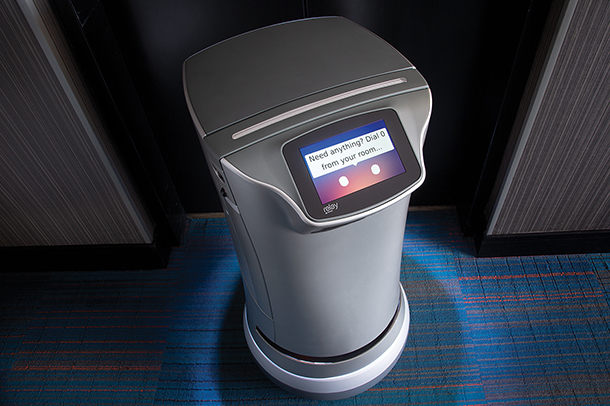
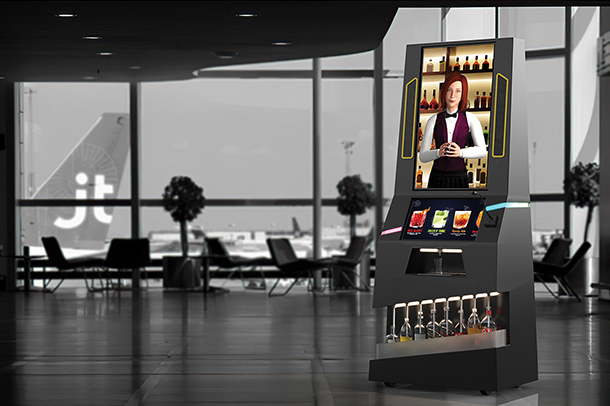
ROBOTS
At least one change will seem like something from a futuristic film. Robots are the children of the pandemic, as their use can increase as enablers of social distancing norms and frontline workers ensuring a safe environment. Robots that bathe a room in ultraviolet light that kills bacteria and germs work between stays in guest rooms while also prowling common areas like the lobby, café, and bars. If you think that sounds like science fiction, note that two are already on the job zapping the invisible in the 273 rooms of the Westin Houston Medical Center Hotel (marriott.com).
Robots also are likely to attend to other backroom tasks, operating behind an ever-smiling human shield wall. With hotels already keen to reduce labor costs, these jobs will likely range from baggage handlers to line cooks to security guards like the two “Xavier” robots fielded in a Singapore mall on the lookout for “undesirable social behaviors” such as smoking and the illegal hawking of goods. A growing number of hotels already use a robot butler called the Savioke Relay, aka “Chip,” to make room deliveries.
As gathering spots become more diverse and decentralized to reduce crowd sizes, robots may be most noticeable as bartenders. Cecilia.ai is already a step in this direction—it features an on-screen virtual bartender that guides customers through the drink order using artificial intelligence and speech recognition tech. A mixed drink is available in 30 seconds. Meanwhile, a humanoid bartending robot named Rob that can chat in eight languages started mixing cocktails this year on a MSC cruise ship.
The recently completed Glass Vault project, a collaborative effort involving, among others, the influential architects Skidmore, Owings & Merrill (shepherds of the towering Project Commodore hotel on Manhattan’s 42nd Street scheduled for a 2030 completion), demonstrated how robots could be used to construct large, complex glass structures with humans applying the glue as needed.
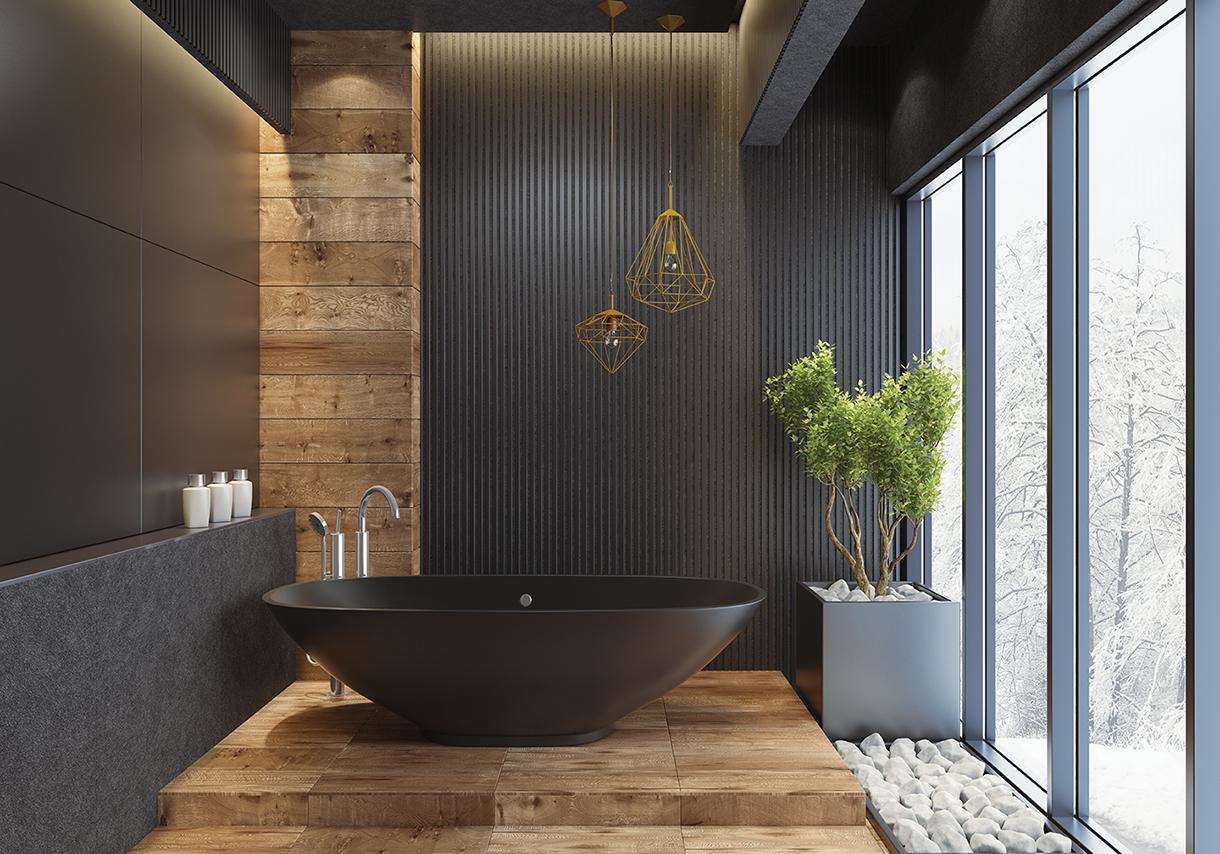
NATURAL LIGHT
But what about the hotel room itself? It’s certainly curtains for curtains. Smart windows that automatically adjust to sunlight intensity minimize heat and glare and reduce energy consumption. View Smart Windows (view.com) do double duty as high-definition displays for videoconferencing, digital whiteboards, and screens for film watching. Smart glass use is being accelerated as a response to the pandemic. It’s a lot easier to clean a glass surface than it is a window treatment, a move that echoes the historical disappearance of bacteria-collecting armoires and the rise of closets. Smart glass that changes from clear to opaque in milliseconds with an app will be used as a partition between the bedroom and the adjoining bathroom for similar hygienic reasons and as a way to distribute more sunlight. Smart glass won’t be just a feature of new construction. A company called PriWatt Film (smartglasstech.com) upgrades existing windows with a coating to alter transparency with a phone app. This year AC Hotel Atlanta Buckhead (marriott.com) installed smart glass in its rooms and removed curtains from the fitness center and pool areas.
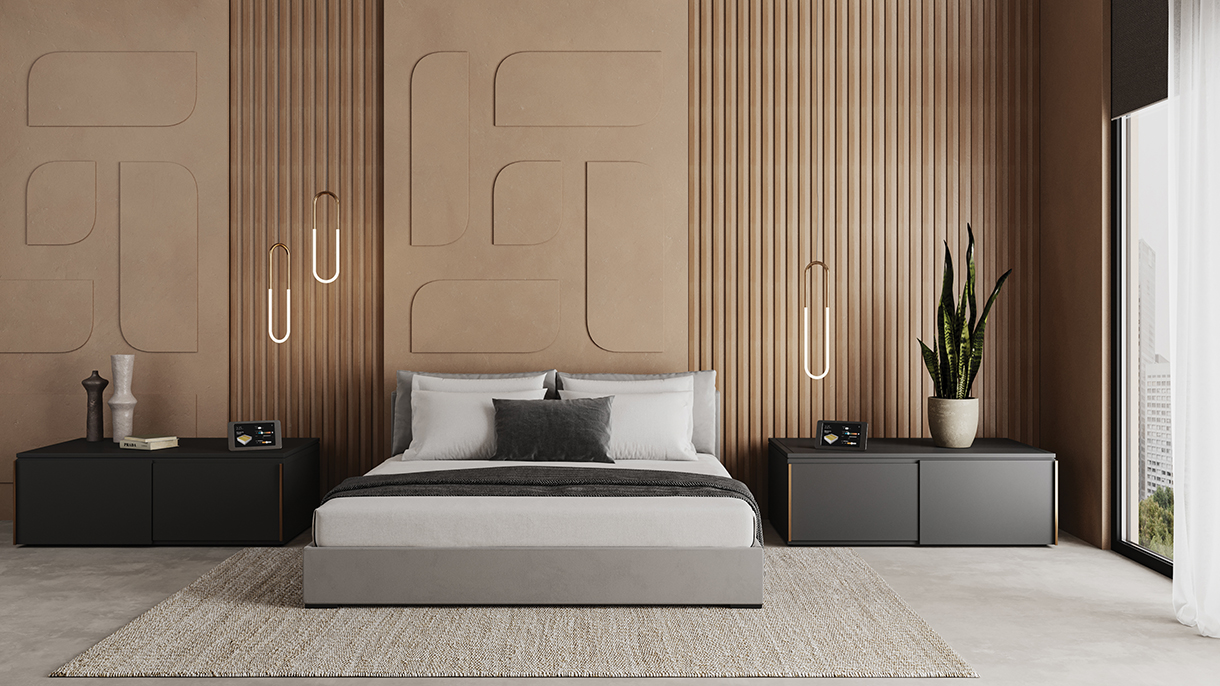
NEW-AGE DÉCOR
Since sleep is almost a luxury item in itself, expect beds equipped with artificial intelligence that learn your sleep patterns over successive nights. The Bryte Restorative Bed is already a fixture at hotels like the Fairmont Scottsdale Princess, Rancho Valencia Resort & Spa, Cavallo Point in San Francisco, the London West Hollywood, and the Park Terrace Hotel on Bryant Park. An embedded sensory network inside the Bryte bed detects biometrics like heart rate and breathing patterns to identify when the sleeper enters the first stage of sleep, triggering cooling features to lower the body’s core temperature and lull sleepers into a deeper rest. One hundred computer-controlled air cushions continually recalibrate support to encourage a longer and more restorative sleep. The bed can even softly nudge the sleeper when it’s time to wake up. Expect bedding material to be anti-microbial, of course.
Desks won’t go away, as they become work centers for travelers or even locals enjoying a “work from home” variant. But some hotel amenities are likely to vanish as they are potentially risky “points of contact.” These include former mainstays like the buffet table, replaced by a wider selection of room service options from local restaurants that have partnered with the hotel—delivered by a robot like one named Rosé already in service at the Hotel Trio (hoteltrio.com) in California’s Wine Country—more grab-and-go meals, and in-room kitchen facilities. Another likely change is the disappearance of the gym packed with exercise equipment in favor of in-room workouts with exercise equipment already in place—think smart exercise mirrors linked to a trainer—or sanitized gear delivered to the room, perhaps by a robot. Alternatively, more workout experiences like yoga classes may move outdoors more often. Likewise, that small, exclusive restaurant on premises may give way to a more desirable expansive setting partially or completely outdoors. Another hotel amenity likely to be transformed are spa treatments that move in-room, executed in larger bathrooms that become private relaxation spaces. Massage apps like Soothe and Zeel have already inspired the spa-less hotel experiences. And here again, smart mirrors in bathrooms will offer everything from news to hotel services.
Decorative pillows, hard-to-clean rugs, and in-room print magazines may disappear while other amenities—even coffee—are in sealed bags. Also on the way out are menus and wine lists, a trend evident in the increased use of QR codes accessed via your phone’s camera. That binder in the drawer that describes hotel services will be replaced by a tablet (if it hasn’t been already). And in the name of sustainability, you may also be more responsible for keeping your hotel room clean—current coronavirus guidelines from the American Hotel & Lodging Association say guest rooms occupied by the same customer over multiple days should not be cleaned daily, unless requested. One small item likely to become widespread, however, is hotel-branded face masks.
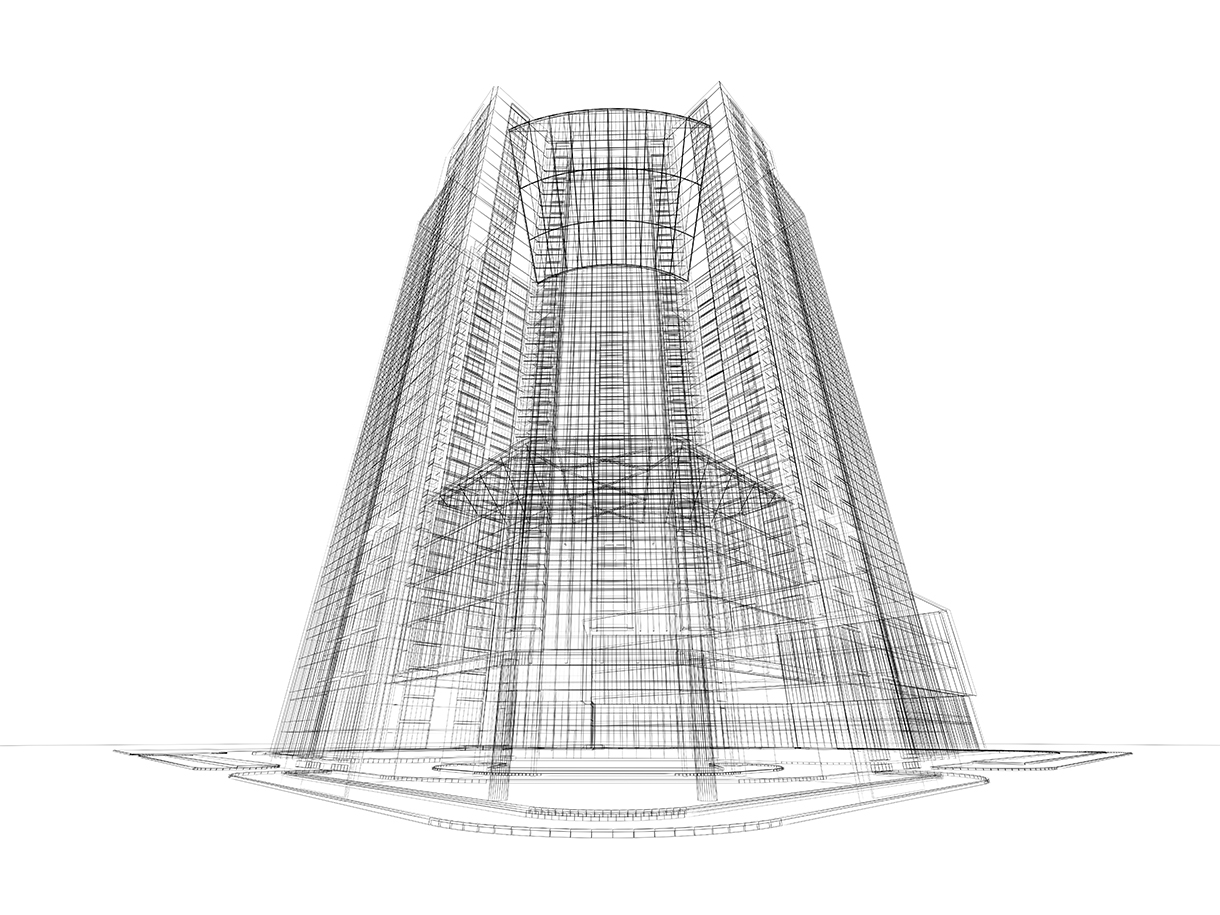
SUSTAINABLE ARCHITECTURE
Sustainability will be a major driver of change and it represents a challenge to energy-intensive hotels. One novel concept is for a circular floating hotel in Qatar, designed by the Hayri Atak Architectural Design Studio, which spins to generate its own electricity like a giant hydro generator. A vortex-shaped roof collects rainwater and wind turbines double as sun umbrellas.
A more near-term example of sustainability is set to open in New Haven, Connecticut, in 2022. A Brutalist office building, characterized by floating concrete modules designed by the iconic Marcel Breuer in 1967, is being rehabilitated after lying vacant for decades as a 165-room boutique accommodation that runs completely on solar power and meets net-zero energy standards. As it happens, the building’s compact shape means it’s naturally energy efficient so it would use significantly less energy than a comparably sized hotel to begin with. More than 1,000 solar panels are to be installed on the roof of the hotel and adjacent parking structures with 500 kilowatts of battery storage for emergencies. Expect to hear more about solar energy as the Biden administration moves to up solar power use in the USA to 40 percent from the current 4 percent by 2050.




